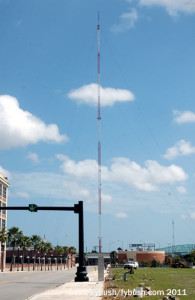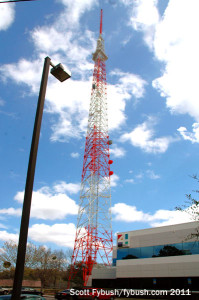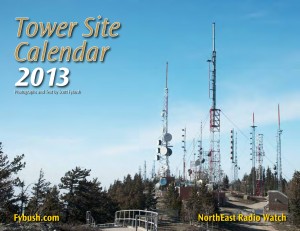NorthEast Radio Watch 12/8/2025: Cichon’s Back in Buffalo
In this week’s issue… Veteran newsman returns - Remembering NY's Leitner, RI's Jones - CT AM saved - Maine AM moves - "Indie" adds suburban signals
Text and photos by SCOTT FYBUSH
A few months ago, we showed you some pictures of Jacksonville, Florida’s oldest radio station, now known as WFXJ (930). Those pictures were tied into the brand-new Tower Site Calendar 2013, and now that it is 2013 and we’re done previewing everything that’s now on your wall (right?), it’s time to break out more of those sunny, warm Florida pictures from February 2011 to counter the chill of Rochester in January. This week’s installment concludes our look at Jacksonville, which started two weeks ago with a drive down Hogan Road, home to most of the market’s TV and FM, and continued last week with a whirlwind journey through many of the city’s smaller AM facilities, most of which we saw in just one busy afternoon.
But we left out a few Jacksonville AM stations in that installment. Of the many, many AM signals in town, there were a few we never got up close to photograph – WNNR (970), with a single tower right off I-95 north of downtown; WJAX (1220), with a single tower near the Jones College campus east of downtown; and WZNZ (1600 Atlantic Beach), also with a single tower way east of downtown out by the ocean. In this week’s installment, we show you everything else, including the biggest Jacksonville AM of all. But before we get to what’s become of the Big APE, we begin our drive south of Jacksonville in the Orange Park area. That’s where the bottom of the area’s AM dial is ably represented by religious WAYR (550 Orange Park), which runs 5000 watts by day and just 65 watts at night from this two-tower array about 15 miles south of downtown Jacksonville. (A few months ago, WAYR was granted a construction permit to change city of license to nearby Fleming Island, remaining at its existing site but boosting night power to 500 watts.)
But Orange Park is better known by radio aficionados as the transmitter and studio home of WAPE (690), one of America’s truly legendary radio stations. Owned by a truly legendary ownership group, the Brennan brothers, WAPE signed on in 1958 with 25,000 watts, daytime-only, from a distinctive modern studio/transmitter building and 500-foot tower just off US 17 here in Orange Park. Low on the dial and right next to the St. John’s River, the call of the Big APE carried for hundreds of miles up and down the Atlantic coast, especially after an early 1960s daytime power boost to 50,000 watts that made WAPE a solid presence on the dial from the Carolinas clear down to south Florida. That big signal was further enhanced by the homebrew engineering work of Bill and Cyril Brennan, Billy Benns and chief engineer Ike Lee. They designed and built their own Doherty transmitters (cooled by the water from the indoor/outdoor swimming pool that flowed right into the station lobby) and their own consoles, all dressed up in distinctive grooved gold-anodized aluminum. (Barry Mishkind has some great pictures here at OldRadio.com, and there are still more at this WAPE tribute site.)
All that mid-century Moderne broadcast techno-geek glory is gone now, alas; as 690 changed hands (about which more in a bit), the Orange Park studios were eventually vacated and then demolished. Where there were once Big APE pool parties, there’s now a senior home, with just a low-profile driveway on one side leading back to the clearing where the tower and a newer transmitter building now sit.
What the APE enjoyed in daytime coverage, it lacked after dark. Constrained by its location on a Canadian/Mexican clear channel, WAPE couldn’t run at night from Orange Park, so the Brennans built a six-tower night site far to the west of Jacksonville. We’ll get there in a moment, but first we’ll take a brief detour to a few more sites in the Orange Park vicinity. Just west of WAYR, there’s a 720-foot tower that was built in 1996 for the early 1997 debut of the market’s new ABC affiliate, Orange Park-licensed WJXX (Channel 25). In the analog era, WJXX’s location so far south of the market’s core meant a less-than-optimal signal, so original owner Allbritton simulcast WJXX on WBSG (Channel 21) in Brunswick, Georgia under an LMA. That ended when Gannett combined WJXX with NBC affiliate WTLV (Channel 12) in 2000, and the use of this site ended in 2009 when the channel 25 analog signal went dark. (WJXX’s digital signal is at the same site as WTLV’s, on the east end of the Hogan Road tower farm we showed you two weeks ago.)
In real life, our journey through Florida left Jacksonville for a week at this point in late February 2011: we headed south to St. Augustine (where we saw only one tower, seen above at right, which is home to religious WAYL 91.9 and WYRE 105.5), and thence on to Daytona Beach, Orlando, Tampa, and beyond. We’ll show you those travels in the weeks to come, but for the sake of continuity, we’ll skip forward to early March 2011 and our return to the Jacksonville area a few hours before returning the rental car and flying home.
We approached Jacksonville from the southwest, shooting up US 301 from Ocala (carefully avoiding the notorious speed traps at Waldo) to approach I-10 eastbound at Baldwin, Florida. Twenty-odd miles due west of downtown Jacksonville, this is where you put an AM signal if it has to be sharply directionalized into town while avoiding interference to Mexican and Canadian AMs. That’s why WAPE put its night signal here, and it’s why another AM with a tight allocations situation ended up out here too. What’s now WJXL (1010) started out in 1947 at the other end of the market, out by the ocean in Jacksonville Beach. Back then it was WJVB, running just 250 watts daytime-only, non-directional, but over the years it boosted day power to 10,000 and then 50,000 watts and added 30,000 watts of night power from its current six-tower site along Lake City Road (US 90) just west of Baldwin.
And so we come back around to the Big APE’s nighttime incarnation. Just east of Baldwin, this site went up in 1963, originally as a 10,000-watt facility shooting a pencil beam of a signal eastward over the center of Jacksonville, but with a pattern so tight that it simply didn’t exist anywhere on the northern or southern sides of the metro. An eventual upgrade to 25,000 watts at night improved the signal strength over the city, but couldn’t do much about the way the pattern is hemmed in, which may explain why it eventually came to pass that the APE couldn’t hold its own on AM against the rise of FM.
But even as WAPE on AM transitioned into religious programming by the mid-1980s, the top-40 Big APE lived on. In 1986, then-WAPE owner Statewide Broadcasting bought what had been WJAX-FM (95.1) from the city of Jacksonville and relaunched it as WAPE-FM. AM 690 ended up with the WJAX calls for a little while, and eventually the great musical-chairs matchup of calls and frequencies in Jacksonville brought the WPDQ calls (originally on 600 and later on 1400) to 690. That was followed in 1994 by one more swap that sent the WPDQ calls back home to 600 and turned 690 into the home of news-talk WOKV, which has been there ever since.


With the demolition of the Orange Park daytime studio/transmitter facility, the Baldwin night transmitter building is the last remaining piece of the Brennan-era WAPE still standing, and we were lucky enough to get a quick peek inside.
The gold-anodized Brennan transmitter is long gone out here, replaced by a Harris during the upgrade to 25 kW. Along the way, the rooms opposite the transmitter and phasor have been mostly cleared out, leaving only a door stenciled “WAPE NEWS” as a reminder that at one time, there were at least minimal studio facilities out here in Baldwin as well, even though most of the APE came from down in Orange Park.
So where’s the modern-day WAPE-FM? It’s in downtown Jacksonville, where we make our last stops before turning back north on I-95 and returning the rental car at the airport.
Several broadcast facilities are in very close proximity to the S-shaped bend the St. John’s River makes as it wends its way through downtown. The historic downtown core sits on the north shore of the bend, and right on the river’s edge is a complex of sports stadiums (including the home of the NFL Jaguars) and parks that also includes two studios and a tower. Just south of the football stadium is the studio that’s home to Jacksonville’s public radio and TV stations, WJCT-TV (Channel 7) and WJCT-FM (89.9), and just west of the stadium is a small pond that separates the studios of WTLV (Channel 12)/WJXX (Channel 25) from the tower that was the birthplace of Channel 12 back in 1957.
Back then, channel 12 was WFGA-TV, and the current WTLV/WJXX studios on East Adams Street are built around the core of the original WFGA-TV studios, which boasted complete local color capability at a time when few other TV stations could make that claim.
WTLV has long since moved out to the Hogan Road tower farm, but its old 1000-foot tower still stands here, now owned by Pittsburgh-based Renda Broadcasting and used by Renda-owned WEJZ (96.1) and WGNE (99.9) and by Cox’s WAPE-FM.
What’s now WEJZ started out way back when as WMBR-FM, part of the pioneering broadcast group that included WMBR (1460) and the city’s first TV station, WMBR-TV (Channel 4), and the original WMBR-FM/TV tower still stands, too, directly across the St. John’s in what’s now the Southbank neighborhood. WMBR-FM was donated to Jones College in the 1960s, becoming WKTZ-FM and moving out to Hogan Road. Eventually, Jones transformed its noncommercial station (originally 10-watt WFAM 91.1) into a new WKTZ and sold off 96.1.
Channel 4, meanwhile, stayed with what became Post-Newsweek Broadcasting, taking new calls WJXT. It eventually moved its transmitter out to the Hogan Road tower farm, but its studios remained in place beneath the old self-supporting tower. Those studios, too, were extensively expanded during the urban renewal that reworked the neighborhood’s roads and renamed the street here “Broadcast Place.”
WJXT has been an independent station since the 2002 affiliation shakeup here that shifted CBS to WTEV (Channel 47), and it’s been quite successful as an indie ever since.
And that’s everything we have to show you about Jacksonville – but we’re far from done with the Sunshine State. In next week’s installment, we’ll make our way down the Atlantic coast to show you the stations of fast-growing Flagler County and then head south to Ormond Beach and Daytona Beach.
 It’s 2013! Do you have your Tower Site Calendar 2013 yet? We’ve still got some left, and they’re shipping right away from the all new Fybush.com store! Order now and your wall can be festooned with Jacksonville and much more all through 2013. (We’ve also got the very last FM Atlas copies available for sale, and the new edition of the National Radio Club’s AM Log.)
It’s 2013! Do you have your Tower Site Calendar 2013 yet? We’ve still got some left, and they’re shipping right away from the all new Fybush.com store! Order now and your wall can be festooned with Jacksonville and much more all through 2013. (We’ve also got the very last FM Atlas copies available for sale, and the new edition of the National Radio Club’s AM Log.)
Want access to more than a dozen years’ worth of Tower Site of the Week? All our archives, fully searchable, are available to Fybush.com subscribers – and you get full access to NorthEast Radio Watch, too! Subscriptions start at just $15. Sign up here!
And don’t miss a batch of Jacksonville-market IDs next Wednesday, over at our sister site, TopHour.com!
Next week: Flagler County and Daytona Beach, Florida
In this week’s issue… Veteran newsman returns - Remembering NY's Leitner, RI's Jones - CT AM saved - Maine AM moves - "Indie" adds suburban signals
In this week’s issue… Scripps stations face takeover - Sinclair moves more affiliations - CT stations sold - Maine AM surrendered - Remembering WVBR's Shapiro, WABC's Morgan
In this week’s issue… CT TV legend succumbs to cancer - Remembering PA's Adams - FCC still stalled by shutdown - Pittsburgh morning host exits
In this week’s issue… FCC faces reopening challenges - Veteran Boston anchor retires - Morning shift in Toronto - NYC FMs expand reach